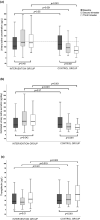A randomized, double-blind study of iodine supplementation during pregnancy in Sweden: pilot evaluation of maternal iodine status and thyroid function
- PMID: 33620551
- PMCID: PMC8354996
- DOI: 10.1007/s00394-021-02515-1
A randomized, double-blind study of iodine supplementation during pregnancy in Sweden: pilot evaluation of maternal iodine status and thyroid function
Abstract
Purpose: Pregnant women in Sweden are mildly iodine deficient. We investigated the effect of daily iodine supplementation on the iodine and thyroid status of pregnant women.
Methods: In this pilot, randomized, double-blind trial, 200 thyroid-healthy pregnant women were recruited at mean (standard deviation) pregnancy week 8.85 (1.62) and assigned (1:1) to daily intake of a multivitamin tablet with or without 150 μg of iodine. Urine and serum samples were collected at baseline and once during the second and third trimesters. Urinary iodine concentration (UIC), serum thyroglobulin (Tg), thyroid-stimulating hormone (TSH), free thyroxine (FT4), and thyroid peroxidase antibodies (TPOabs) were analyzed. Neonatal TSH data were collected. UIC and Tg were also analyzed in a group of 89 thyroid-healthy non-pregnant women of reproductive age (WRA).
Results: At baseline, the intervention and the control groups had similar median UIC (interquartile range (IQR)): 110 μg/L (74-119) and 111 μg/L (66-168), respectively. The intervention group reached iodine sufficiency with median UIC (IQR) 139 μg/L (89-234) and 136 μg/L (91-211) in the second and third trimester, respectively, without significant difference from the lower limit of the recommended range, i.e. 150-250 μg/L (p = 0.42 and p = 0.87, respectively). The intervention group had higher median UIC and lower median Tg compared to the control group during the second (p < 0.001 and p = 0.019, respectively) and third trimester (p < 0.001 and p = 0.003, respectively), whereas thyroid hormones, serum TPOabs, and neonatal TSH were similar. The WRA group presented median UIC (IQR) 65 μg/L (30-98) and median Tg (IQR) 18 μg/L (13-27).
Conclusion: A daily supplement containing 150 μg of iodine to a group of pregnant women with mild iodine deficiency improved the iodine status from mild ID to iodine sufficiency. This improvement seems to have had a positive impact on maternal thyroglobulin. This study is now under extension to investigate the children's neuropsychological development.
Trial registration: ClinicalTrials.gov Identifier NCT02378246, May 3, 2015, retrospectively registered.
Keywords: Iodine supplementation; Pregnancy; Randomized controlled trial; Sweden; Thyroglobulin; Urinary iodine concentration.
© 2021. The Author(s).
Conflict of interest statement
The authors declare that they have no conflicts of interest. The funding sponsors had no role in the design of the study, in the collection, analyses, or interpretation of data, in the writing of the manuscript, or in the decision to publish the results.
Figures

Similar articles
-
Effects of an Iodine-Containing Prenatal Multiple Micronutrient on Maternal and Infant Iodine Status and Thyroid Function: A Randomized Trial in The Gambia.Thyroid. 2020 Sep;30(9):1355-1365. doi: 10.1089/thy.2019.0789. Epub 2020 Apr 28. Thyroid. 2020. PMID: 32183608 Free PMC article. Clinical Trial.
-
Evaluation of Iodine Nutritional Status Among Pregnant Women in China.Thyroid. 2020 Mar;30(3):443-450. doi: 10.1089/thy.2019.0001. Thyroid. 2020. PMID: 31964276
-
Iodine nutrition level and thyroid function in pregnant women in the Yongchuan district of Chongqing.J Clin Transl Res. 2022 Nov 10;8(6):516-522. eCollection 2022 Dec 29. J Clin Transl Res. 2022. PMID: 36452005 Free PMC article.
-
Thyroglobulin as a biomarker of iodine deficiency: a review.Thyroid. 2014 Aug;24(8):1195-209. doi: 10.1089/thy.2014.0052. Epub 2014 Jun 12. Thyroid. 2014. PMID: 24762031 Free PMC article. Review.
-
Thyroglobulin Concentration and Maternal Iodine Status During Pregnancy: A Systematic Review and Meta-Analysis.Thyroid. 2020 May;30(5):767-779. doi: 10.1089/thy.2019.0712. Epub 2020 Feb 7. Thyroid. 2020. PMID: 31910106
Cited by
-
Preconception Counseling in Patients with Hypothyroidism and/or Thyroid Autoimmunity.Medicina (Kaunas). 2022 Aug 18;58(8):1122. doi: 10.3390/medicina58081122. Medicina (Kaunas). 2022. PMID: 36013589 Free PMC article. Review.
-
Iodine Deficiency, Maternal Hypothyroxinemia and Endocrine Disrupters Affecting Fetal Brain Development: A Scoping Review.Nutrients. 2023 May 9;15(10):2249. doi: 10.3390/nu15102249. Nutrients. 2023. PMID: 37242131 Free PMC article.
-
Iodine nutritional status in different trimesters of pregnancy and its association with dietary habits: a prospective observational study in Taiwan.BMC Pregnancy Childbirth. 2025 Mar 20;25(1):323. doi: 10.1186/s12884-025-07445-y. BMC Pregnancy Childbirth. 2025. PMID: 40114096 Free PMC article.
-
HPLC Analysis of the Urinary Iodine Concentration in Pregnant Women.Molecules. 2021 Nov 10;26(22):6797. doi: 10.3390/molecules26226797. Molecules. 2021. PMID: 34833891 Free PMC article.
-
Micro-nutrient sufficiency in mothers and babies: management of deficiencies while avoiding overload during pregnancy.Front Nutr. 2025 Apr 1;12:1476672. doi: 10.3389/fnut.2025.1476672. eCollection 2025. Front Nutr. 2025. PMID: 40236637 Free PMC article. Review.
References
-
- Stinca S, Andersson M, Weibel S, Herter-Aeberli I, Fingerhut R, Gowachirapant S, Hess SY, Jaiswal N, Jukic T, Kusic Z, Mabapa NS, Nepal AK, San Luis TO, Zhen JQ, Zimmermann MB. Dried blood spot thyroglobulin as a biomarker of iodine status in pregnant women. J Clin Endocrinol Metab. 2017;102(1):23–32. doi: 10.1210/jc.2016-2829. - DOI - PubMed
-
- Stanbury JB, Ermans AM, Hetzel BS, Pretell EA, Querido A. Endemic goitre and cretinism: public health significance and prevention. WHO Chron. 1974;28(5):220–228. - PubMed
Publication types
MeSH terms
Substances
Associated data
Grants and funding
LinkOut - more resources
Full Text Sources
Other Literature Sources
Medical
Miscellaneous

